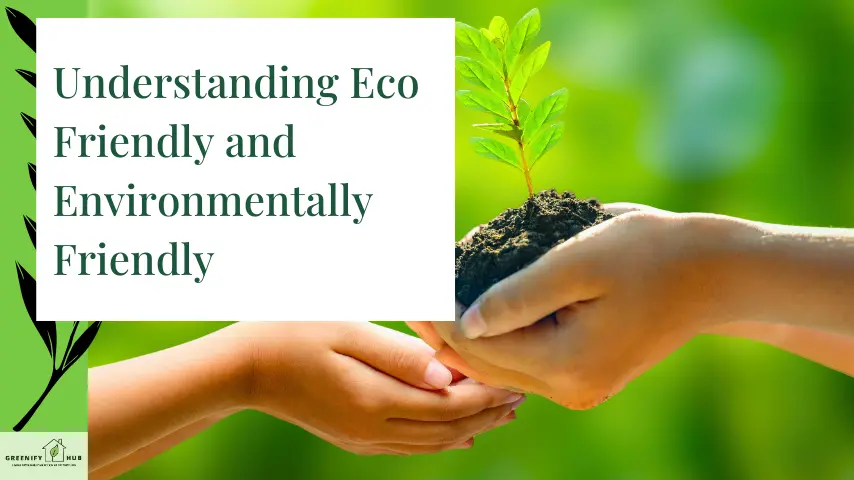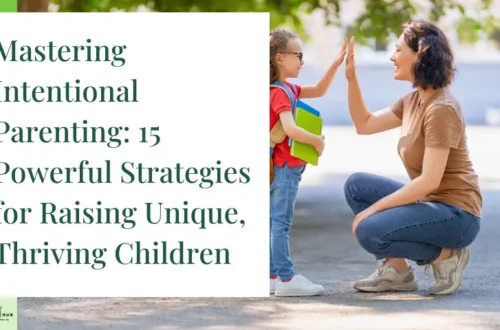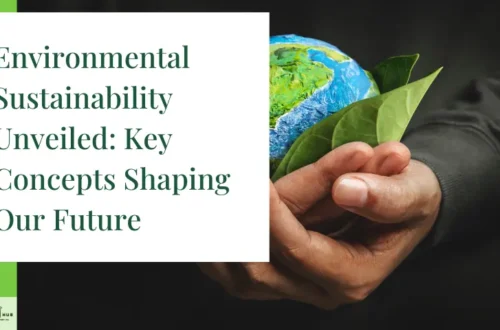Understanding Eco Friendly and Environmentally Friendly

In the realm of sustainability, two terms often pop up: eco friendly and environmentally friendly. But what do they really mean?
Eco-friendly is a broad term that encompasses products, practices, or lifestyles that don’t harm the environment. It’s like that reusable water bottle you carry around – it’s doing its part to reduce plastic waste.
On the other hand, environmentally friendly is a more specific term. It refers to things that actively benefit the environment. Think of solar panels on a roof – they’re not just avoiding harm, they’re actually helping by producing clean energy.
Both terms share a common goal: to be kind to our planet. They’re the friendly words we use in an environmental context to describe efforts that protect our natural world.
But here’s the catch: nothing is truly 100% eco-friendly. Even that reusable water bottle had to be manufactured, which used some resources. The key is to aim for the least harmful option available.
So, next time you see these terms, remember: they’re pointing in the right direction, but it’s up to us to dig deeper and understand the full impact of our choices.
Eco-friendly and environmentally friendly are positive terms indicating efforts to protect the environment, but it’s crucial to look beyond labels and understand the full impact of products and practices.
Sustainability: Preserving Resources for Future Generations
Sustainability is more than just a buzzword – it’s a way of living that ensures we’re not depleting Earth’s resources faster than they can regenerate. It’s about finding a balance between our needs today and the needs of future generations.
Imagine you have a jar of cookies. Sustainable living is like eating just one cookie a day, so the jar never empties. It’s about using resources wisely, so there’s always enough to go around.
The Three Pillars of Sustainability
Sustainability rests on three main pillars:
1. Environmental Sustainability: This involves protecting our ecosystems and natural resources. It’s about reducing pollution, conserving biodiversity, and mitigating climate change.
2. Economic Sustainability: This ensures that economic growth doesn’t come at the cost of social and environmental well-being. It promotes a circular economy where resources are used, reused, and recycled efficiently.
3. Social Sustainability: This focuses on maintaining and improving social well-being. It includes aspects like social development, equality, and access to education and healthcare.
These pillars are interconnected. For instance, sustainable development in a community might involve setting up a solar farm (environmental) that creates jobs (economic) and provides clean energy to local homes (social).
The word sustainability has evolved from a niche term to a global imperative. It’s now at the heart of many government policies, business strategies, and individual lifestyle choices.
However, measuring sustainability can be tricky. There’s no universal yardstick. What’s considered sustainable can vary based on context, available technologies, and cultural norms.
Sustainability is a holistic approach to living that balances environmental protection, economic growth, and social well-being to ensure resources are available for future generations.
Green: Beyond Color to Conscious Living
When we talk about being “green,” we’re not discussing paint swatches or your favorite t-shirt color. In the environmental context, green is shorthand for a lifestyle that’s mindful of its impact on the natural world.
Being green is like being a good neighbor to Mother Nature. It’s about making choices that respect and protect our environment. This could mean opting for a bike ride instead of driving, choosing products with minimal packaging, or supporting businesses that prioritize sustainability.
Green living recognizes that we’re part of a larger ecosystem. Every action we take – from the food we eat to the energy we use – has ripple effects on the natural elements around us.
For example, a green approach to gardening might involve:
– Using natural pest control methods instead of chemical pesticides
– Composting kitchen scraps to create nutrient-rich soil
– Planting native species that support local wildlife
Remember, going green isn’t about perfection. It’s about progress and making conscious choices whenever possible to reduce our environmental footprint.
“Green” in an environmental context refers to lifestyle choices and practices that aim to minimize harm to the natural world and promote ecological balance.
Greenwashing: Navigating False Environmental Claims
Imagine walking into a store and seeing a product labeled “eco-friendly” in big, green letters. Sounds great, right? But what if that’s the only green thing about it? Welcome to the world of greenwashing.
Greenwashing is when companies make their products seem more environmentally friendly than they really are. It’s like putting a green bow on a gas-guzzling car and calling it eco-friendly.
Here’s how it often plays out:
1. Vague Claims: A product might say it’s “all-natural” without explaining what that means.
2. Hidden Trade-offs: A product might be recyclable, but its production process is highly polluting.
3. Irrelevant Claims: Labeling something as “CFC-free” when CFCs are banned anyway.
4. Lack of Proof: Companies make green claims without any evidence to back them up.
Greenwashing can significantly influence consumer behavior. When we see a green label, we often feel good about our purchase. But this good feeling can be misleading if the product isn’t truly sustainable.
So, how can we avoid falling for greenwashing?
– Look for specific claims and certifications
– Research the company’s overall practices
– Be wary of over-the-top green marketing
– Check for transparency in the product’s lifecycle
Remember, a truly sustainable product will be backed by concrete information, not just trendy green buzzwords.
Greenwashing is the practice of making false or exaggerated environmental claims, and consumers can combat it by being skeptical, doing research, and looking for specific, verifiable information.
Check out the video below for Greenwashing Insights from Anuraag:
Waste Reduction Approaches
In our journey towards a more sustainable lifestyle, tackling waste is a crucial step. Let’s explore some key approaches to reducing waste:
Zero-Waste vs. Minimal Waste vs. Low Waste
These terms represent different levels of commitment to waste reduction:
1. Zero-Waste: This is the gold standard. It aims to send nothing to landfill, incineration, or the ocean. Think of it as a closed-loop system where everything is reused, recycled, or composted.
2. Minimal Waste: This approach focuses on significantly reducing waste, but acknowledges that zero waste might not always be achievable. It’s about making conscious choices to minimize waste wherever possible.
3. Low Waste: This is often the starting point for many. It involves making simple swaps to reduce waste, like using reusable shopping bags or water bottles.
Each of these approaches can be applied at both individual and business levels. For instance, a consumer-facing business might start with low waste practices in their office before implementing more comprehensive zero-waste strategies in their production line.
Food waste is a particular concern in waste reduction efforts. Did you know that about one-third of all food produced globally goes to waste? Here are some tips to reduce food waste:
– Plan meals and shop with a list
– Store food properly to extend its life
– Use leftovers creatively
– Compost food scraps
Remember, the goal isn’t perfection, but progress. Every small step towards reducing waste counts!
Waste reduction approaches range from zero-waste to low waste, each representing different levels of commitment, but all contributing to a more sustainable lifestyle and reduced environmental impact.
Low Impact Living: A Holistic Approach
Low impact living is like tiptoeing through life, leaving the smallest footprint possible on our planet. It’s a holistic approach that considers every aspect of our lifestyle and its effect on the environment.
At the heart of low impact living is the idea of reducing our carbon footprint. This invisible trail of greenhouse gases we leave behind comes from everything we do – from the food we eat to the way we travel.
Here are some key areas where we can lower our impact:
1. Energy Use: Improving energy efficiency at home can make a big difference. This could mean using LED bulbs, insulating your home better, or even installing solar panels.
2. Transportation: Opting for public transport, carpooling, or cycling can significantly reduce emissions.
3. Consumption: Buying less, choosing second-hand items, and opting for products with minimal packaging all help.
4. Food: Eating locally, reducing meat consumption, and growing your own vegetables can lower your food-related impact.
5. Water: Simple actions like fixing leaks, collecting rainwater for gardening, and taking shorter showers all contribute.
Remember, low impact living isn’t about depriving yourself. It’s about making mindful choices that align with your values and help protect our planet.
Low impact living is a comprehensive approach to reducing one’s environmental footprint across all aspects of life, from energy use to consumption habits.
The 3Rs: Recycling, Reusing, and Reducing
The 3Rs – Reduce, Reuse, Recycle – are the holy trinity of sustainable living. They’re like a simple recipe for a healthier planet. Let’s break them down:
1. Reduce: This is the most important R. It’s about using less in the first place. For example:
– Buy only what you need
– Choose products with less packaging
– Opt for digital versions of books and magazines
2. Reuse: This means finding new uses for things instead of tossing them out. For instance:
– Use glass jars for storage
– Repurpose old clothes into cleaning rags
– Donate items you no longer need
3. Recycle: This involves turning waste into new products. While important, it should be the last resort after reducing and reusing. Remember to:
– Know what can be recycled in your area
– Clean items before recycling
– Avoid “wishcycling” – putting non-recyclable items in the recycling bin
The 3Rs help conserve our renewable resources and reduce the need for new raw materials. They’re key to creating more sustainable products and moving towards a circular economy.
Here’s a fun fact: Recycling one aluminum can saves enough energy to run a TV for three hours!
By embracing the 3Rs, we’re not just managing waste – we’re rethinking our relationship with stuff. It’s about valuing what we have and making the most of our resources.
The 3Rs – Reduce, Reuse, Recycle – provide a simple yet effective framework for minimizing waste and conserving resources, with reducing consumption being the most impactful step.
Plastic-Free Living: Challenges and Solutions
Imagine a world without plastic. Sounds impossible, right? While completely eliminating plastic is a huge challenge, we can certainly reduce our plastic consumption. Here’s why it matters and how we can do it:
Why go plastic-free?
– Plastic pollutes our oceans and harms marine life
– It takes hundreds of years to decompose
– Many plastics release harmful chemicals
Challenges:
1. Convenience: Plastic is everywhere because it’s convenient
2. Cost: Plastic-free alternatives can sometimes be more expensive
3. Availability: Plastic-free options aren’t always readily available
Solutions:
1. Carry reusable bags, water bottles, and food containers
2. Choose products with minimal or biodegradable packaging
3. Opt for natural materials like bamboo, glass, or stainless steel
4. Support businesses that offer plastic-free or refill options
Remember, it’s not about being perfect. Even small changes can make a big difference. For example, swapping plastic straws for reusable ones or choosing compostable materials over plastic can significantly reduce your plastic footprint.
When shopping, look for biodegradable products or those made from compostable materials. These break down naturally, unlike traditional plastics.
While completely eliminating plastic is challenging, adopting plastic-free alternatives and making conscious choices can significantly reduce plastic waste and its environmental impact.
Debunking “Chemical Free” Claims
Ever seen a product labeled “chemical free”? Here’s a secret: there’s no such thing! Everything is made of chemicals, even water (H2O) and air (mostly nitrogen and oxygen).
When companies use the term “chemical free,” they usually mean free from synthetic or artificial chemicals. But this claim can be misleading:
1. It’s scientifically inaccurate
2. It plays on fears about chemicals
3. It doesn’t guarantee safety (some natural chemicals can be harmful)
Instead of looking for “chemical free,” focus on understanding the ingredients. Look for products that:
– Use naturally derived ingredients
– Avoid known harmful substances
– Are transparent about their ingredients
Remember, “natural” doesn’t always mean safe, and “synthetic” doesn’t always mean harmful. It’s all about the specific ingredients and how they’re used.
Next time you see a “chemical free” claim, take it with a grain of salt (which, by the way, is also a chemical – sodium chloride!).
The term “chemical free” is misleading and scientifically inaccurate; instead, focus on understanding product ingredients and their effects.
Organic: Beyond Food to Lifestyle
When we hear “organic,” most of us think of food. But organic is more than just what’s on your plate – it’s a holistic approach to living in harmony with nature.
In farming, organic means:
– No synthetic pesticides or fertilizers
– No genetically modified organisms (GMOs)
– Sustainable farming practices
But organic extends beyond food:
1. Clothing: Organic cotton is grown without harmful pesticides
2. Skincare: Organic beauty products use natural ingredients
3. Home goods: From bedding to cleaning products, organic options abound
Organic matter in soil is crucial for healthy ecosystems. It improves soil structure, retains water, and supports beneficial microorganisms.
Choosing organic isn’t just about personal health. It’s about supporting a system that’s better for the environment, farm workers, and biodiversity.
Remember, “organic” is a regulated term for food in many countries. For non-food items, look for certified organic materials and transparent production practices.
Organic extends beyond food to encompass a lifestyle that prioritizes natural, sustainable practices in various aspects of daily life, from clothing to home goods.
Natural: Unraveling an Unregulated Term
“Natural” is a term we see everywhere, from food labels to cosmetics. But what does it really mean?
Here’s the catch: “Natural” isn’t regulated. Unlike “organic,” there’s no standard definition or certification for “natural” products.
Generally, “natural” implies:
– Ingredients from nature (plants, minerals)
– Minimal processing
– No synthetic additives
But without regulations, interpretations vary widely. A “natural” product might still contain:
– Processed ingredients
– GMOs
– Some synthetic components
When shopping, don’t just trust the “natural” label. Look deeper:
– Check the ingredient list
– Research unfamiliar ingredients
– Look for specific claims (e.g., “no artificial colors”)
Remember, natural doesn’t always mean safe or sustainable. Poison ivy is natural, but you wouldn’t want it in your lotion!
“Natural” is an unregulated term open to interpretation; consumers should look beyond the label to understand product ingredients and processing methods.
Composting: Home vs. Industrial Processes
Composting is nature’s way of recycling. It turns organic waste into nutrient-rich soil. But not all composting is the same. Let’s compare home and industrial composting:
Home Composting:
– Done in backyards or small-scale settings
– Uses food scraps, yard waste
– Relies on natural decomposition
– Takes weeks to months
– Great for gardening
Industrial Composting:
– Large-scale facilities
– Can handle more types of waste
– Uses controlled conditions (temperature, moisture)
– Faster process (weeks)
– Produces compost for commercial use
Both methods reduce waste and create valuable soil. They cut down on landfill use and decrease methane emissions.
Some materials, like certain bioplastics, only break down in industrial facilities. Check labels to know where to dispose of these items.
Remember, composting is a natural process that mimics nature’s own recycling system. Whether at home or in a facility, it’s a great way to give back to the earth.
Both home and industrial composting contribute to waste reduction and soil enrichment, but they differ in scale, process, and types of materials they can handle.
Biodegradability: Understanding the Breakdown
Biodegradability sounds great, right? It means something will break down naturally. But it’s not as simple as it seems.
Here’s what you need to know:
1. Time varies: Some items biodegrade in weeks, others take years
2. Conditions matter: Temperature, moisture, and microorganisms affect breakdown
3. Not all “biodegradable” products are eco-friendly
Consider the entire lifecycle of a product:
– How was it made?
– What resources were used?
– Does it leave any harmful residues?
For example, a biodegradable plastic bag might seem eco-friendly. But if it’s made from fossil fuels and leaves microplastics behind, is it really better?
Biodegradability doesn’t erase man-made damage. A product that lasts longer and can be reused might be more sustainable than a single-use biodegradable one.
When shopping, look beyond the “biodegradable” label. Consider the product’s overall environmental impact.
Biodegradability is complex and doesn’t guarantee environmental friendliness; consider a product’s entire lifecycle and overall impact on the environment when evaluating its sustainability.
Conclusion
As we navigate the complex landscape of sustainable living, understanding these 13 eco terms empowers us to make informed choices and contribute positively to our planet’s future. By decoding green lingo, we can avoid falling prey to greenwashing and embrace authentic environmentalism. Remember, sustainable living is a journey, not a destination. Every small step towards reducing our carbon footprint, choosing sustainable products, and supporting ethical businesses makes a difference.
Let’s embrace this knowledge to foster a more sustainable lifestyle, keeping in mind the interconnectedness of our actions with the natural world. As conscious consumers, we have the power to drive positive change through our daily choices. By applying these insights, we can collectively work towards a greener, more sustainable future for generations to come.
Thank you for joining us on this exploration of eco-friendly terminology. Together, we can turn understanding into action and pave the way for a more sustainable world. Let’s start making a difference today!





